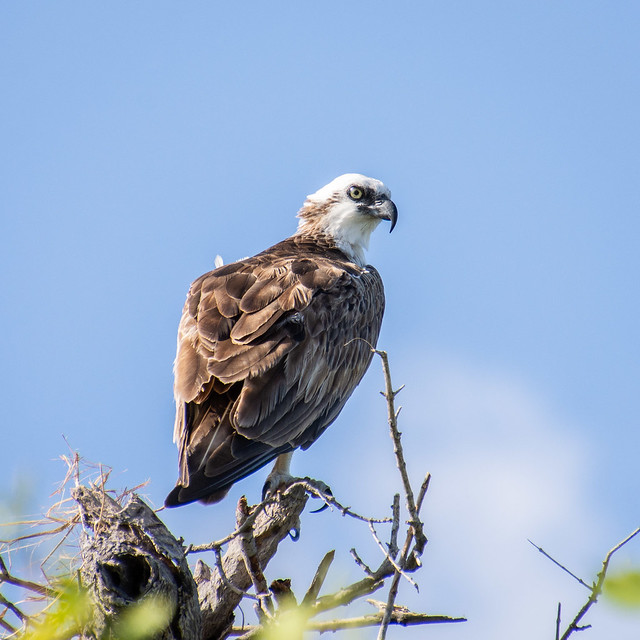Hawks are medium-sized birds of prey with large eyes, hooked beaks, and sharp, curved claws. Despite being similar in appearance and behaviour, they don’t all belong to the same family.
Osprey
Osprey can be found near lakes, rivers, and coasts during the summer months. They’re large birds with a 5-6 ft wingspan, brown above and white below with a white head and a brown stripe across the eyes and cheeks. When they fly, there is a distinctive kink in their wings in the shape of an M. Bald eagles frequent similar habitats but they’re larger and don’t have the osprey’s white underparts.
If you're lucky, you'll spot an osprey plunging feet first into a lake to catch a fish in its claws. They build large stick nests near water on poles or dead trees.
Did you know? Osprey are the only North American hawk to catch and eat live fish. They have gripping pads on their feet to help them hold and carry the fish for long distances.
Red-tailed Hawk
Red-tailed hawks are common in southern Canada during the summer months. Look for them soaring in circles over open fields or perched on poles and fence posts. Red-tailed hawks have a 4-ft wingspan, a rusty-red tail, a pale face, and paler underparts. They have broad rounded wings and a short wide tail. A dark bar at the edge of their wings is visible in flight.
Did you know? Red-tailed hawks are one of the largest North American birds, but they weigh at most 3 pounds. Dogs of a similar size would weigh 10 times as much.
Sharp-shinned hawks (Sharpies) are the smallest North American hawk (9-14 in) with a small head, short wings, long legs, and long tail. They can be hard to spot as they hide in bushes and wooded areas, ready to leap out and pounce on passing songbirds. Merlins are a similar size but have pointed wings, a shorter tail, and usually hunt in the open.
Sharp-shinned hawks have a dark grey back and head and a white breast with reddish-orange streaks. Juveniles have a brown back and head. There are broad dark bands across their tail.
Sharp-shinned hawks spend their summers in the dense, coniferous forests of Alaska, Canada and the northern plains of the United States, heading south to spend their winters in the United States.
Did you know? Small birds make up 90% of the sharp-shinned hawks' diet and are plucked before being eaten.
Swainson’s Hawk
Swainson's hawks are a common sight in summer, soaring over the prairies and open grasslands of western North America. They prefer wide open spaces where they can easily spot ground squirrels and other small rodents, their preferred food when they are breeding. They also eat lots of grasshoppers – hence their alternate name of grasshopper hawk.
Swainson's hawks vary in colour, but they usually have a dark breast, a light-coloured belly, and brown or grey upper parts. Most males have grey heads, while most females have brown heads. The large white patches edged with black flight feathers on their underwings help to identify them when they are in flight. Swainson's hawks are slimmer and longer-winged than other hawks.
Did you know? Swainson's Hawks' long migration to Argentina can take up to two months. Their large migratory flocks number in the tens of thousands and they may travel for several days without feeding.
Nature Companion
You’ll find lots more information about birds on EcoFriendly Sask’s Nature Companion, an entry-level nature app for Canada’s four western provinces.
See Also




